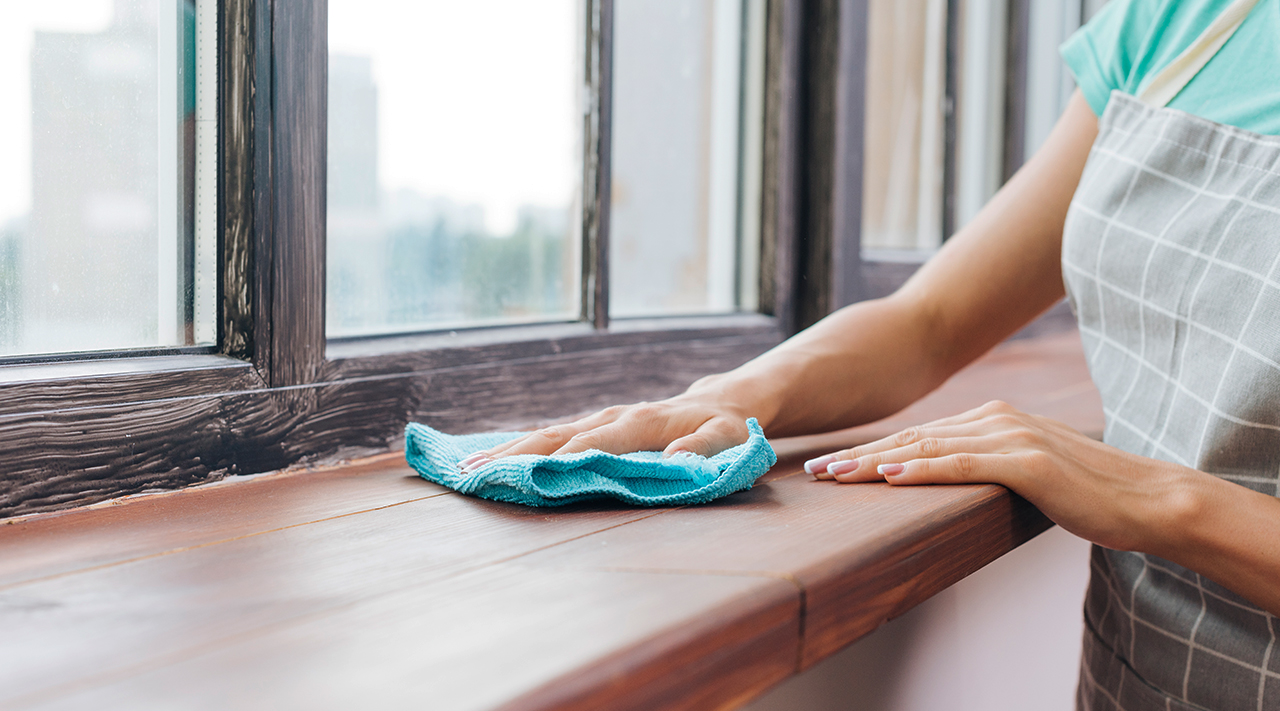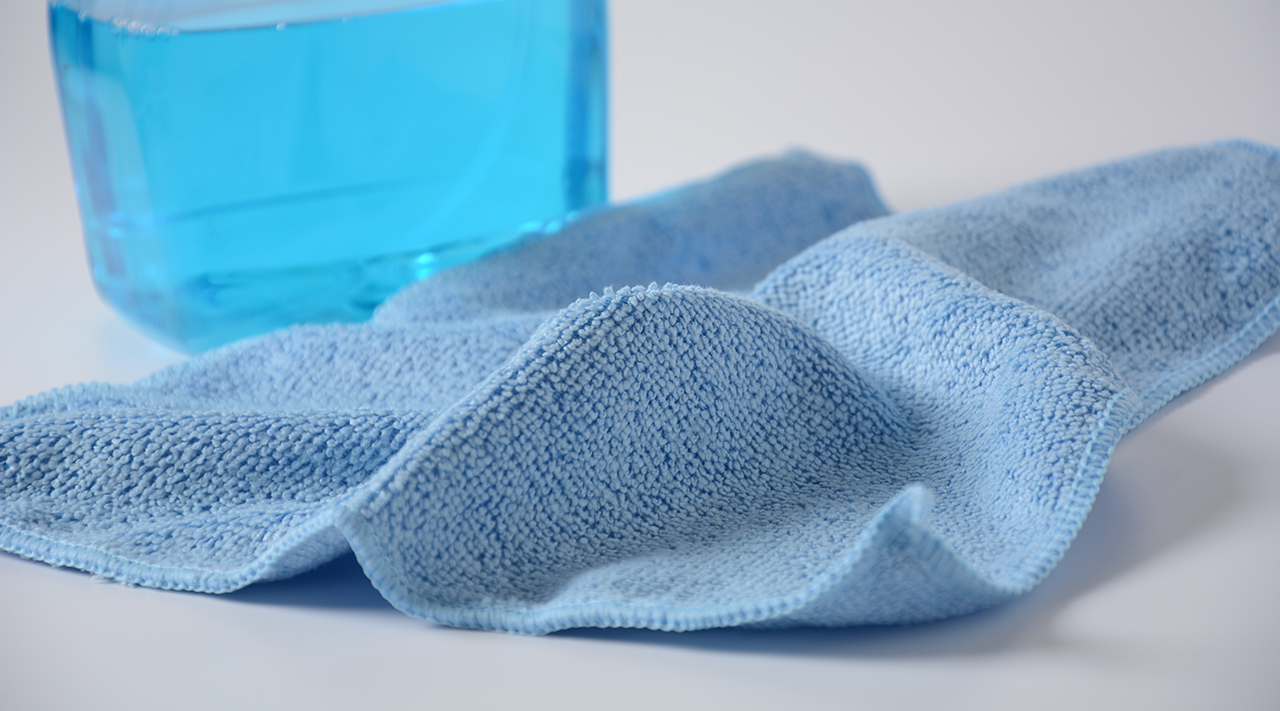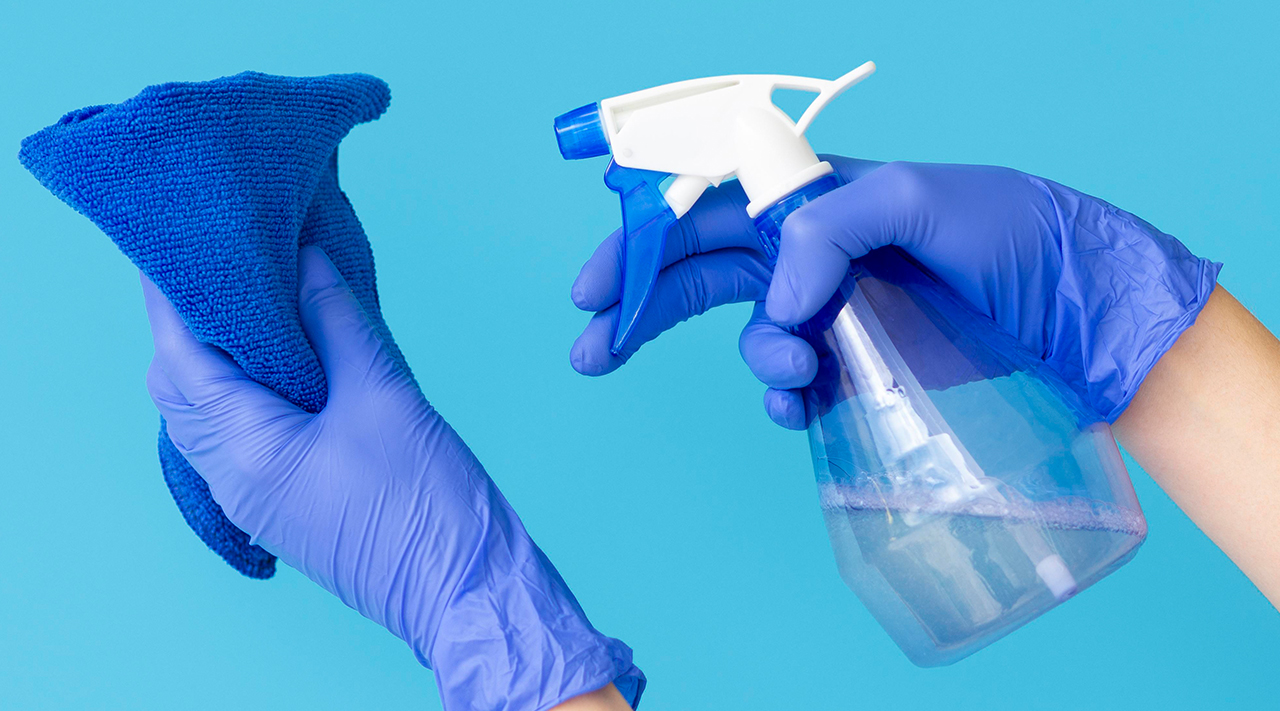Microfiber cloths are essential tools for effective cleaning, but keeping them truly hygienic requires proper care. Knowing how to disinfect microfiber cloths ensures they stay free from bacteria and continue performing at their best.
In this guide, we’ll explain the best way to clean microfiber cloths, including when to wash, how to sanitize them safely, and what products to avoid, so your cleaning routine remains both effective and germ-free.
Cleaning vs. Sanitizing vs. Disinfecting: Differences When Disinfecting Microfiber Cloths
Understanding the difference between cleaning, sanitizing, and disinfecting is key to keeping microfiber cloths effective and hygienic. Each process plays a unique role in maintaining both cleanliness and longevity.
1. Cleaning
Cleaning focuses on removing visible dirt, dust, and debris from microfiber cloths.
-
It doesn’t kill germs but physically removes them from the fibers.
-
Use warm water and a mild detergent to wash away residues after each use.
-
Avoid fabric softeners or bleach, which can damage the fibers and reduce absorbency.
When to do it: After every use or daily if used for routine surface cleaning.
2. Sanitizing
Sanitizing reduces the number of bacteria on microfiber cloths to safe levels as defined by public health standards.
-
This step targets bacteria but not all viruses or spores.
-
You can sanitize by washing in hot water (above 160°F / 70°C) or using a sanitizer-safe laundry additive.
-
Always rinse thoroughly to maintain fiber performance.
When to do it: Regularly, especially for cloths used in kitchens, gyms, or other high-touch environments.
3. Disinfecting
Disinfecting goes one step further, it kills nearly all pathogens, including bacteria and viruses, on the cloth.
-
Use an approved disinfectant compatible with microfiber materials.
-
Never soak cloths in bleach unless the manufacturer confirms it’s safe (many microfibers degrade in bleach).
-
Allow proper contact time, then rinse and air dry completely.
When to do it: Weekly, or after cleaning contaminated or high-risk areas such as restrooms or healthcare settings.
How to Clean Microfiber Cloths
Before jumping into the specifics of how to disinfect your microfiber cloths, it's essential first to understand what they're made of and why treating them ideally is crucial. Microfiber cloths are composed of millions of synthetic fibers finer than one denier or decitex/thread - this is approximately 1/5th the diameter of a human hair!
These minuscule fibers create a large surface area that not only improves their cleaning power but also heightens their capability to retain dust and dirt. According to a report by Verified Market Reports, such characteristics lessen the need for chemical cleaning solutions and promote environmentally friendly behaviors.
However, there's a caveat - this impressive performance means that microfibers can easily trap bacteria and other microbes after use. This makes appropriate cleansing critical if you want your cloth to perform at their best perpetually.
Cleaning these cloths involves two primary steps: washing and disinfection. Washing aids in removing physical contaminants while disinfectants work towards killing or inactivating pathogens that might be present on the cloth—providing you with a thoroughly cleaned material ready for your next cleaning task.
Ideal microfiber cloth care also helps extend its lifetime, ensuring you get the most out of your investment. So how can you ensure you're cleaning them correctly? Stay tuned as we delve into effective methods to disinfect microfiber cloths.

Types of Disinfectants for Microfiber Cloths
Choosing the right disinfectant for microfiber cloths is essential to maintaining both hygiene and fabric integrity. While microfiber is durable, certain chemicals can weaken its fibers or reduce cleaning performance. Below are the safest and most effective disinfectant options to consider.
Properly disinfecting microfiber cloths is crucial for maintaining cleanliness and promoting hygiene. Here are several ways to treat and disinfect your microfiber cloths:
Hot Water
Washing with hot water kills germs effectively due to high temperatures. An optimal temperature for doing so is between 140°F - 150°F.
Bleach
Bleach can eliminate bacteria or viruses but should be used sparingly as it can damage the cloth's fibers and reduce effectiveness.
White Vinegar
White vinegar is a natural disinfectant. Mix equal parts of white vinegar and water, then soak the microfiber cloths in this solution for at least 30 minutes. Vinegar’s acidity helps break down bacteria and germs, leaving your cloths sanitized and the fresh.
How to Disinfect Microfiber Cloths: Step-by-Step Guide
Here's a step-by-step guide simplifying how to sterilize cleaning cloths:
- Shake off any loose dirt from the cloth.
- Prepare a solution of warm water (140°F) and mild detergent.
- Saturate the cloth completely in the cleaning solution.
- Allow it to soak for about half an hour.
- Rinse thoroughly until all detergent is flushed away, then air dry.
Follow this process diligently each time to ensure maximum hygiene and the prolonged lifespan of your microfibers!
Maintaining the Quality of Your Microfiber Cloths Over Time
Disinfecting your microfiber cloths is undoubtedly crucial, but understanding how to maintain their condition over time is equally important. Ensuring longevity will not only save you money but also contribute to a sustainable lifestyle.
Mindful Usage
Remember that these delicate textiles are not suitable for all surfaces or jobs around the house. For example, microfiber cloths are not ideal for sharp edges or rough surfaces as they may tear.
Wash Responsibly
To wash your microfibers effectively:
• Separate them from other laundry items. Washing them with regular clothes can result in lint build-up.
• Use a mild detergent without bleach or fabric softener as such additives might destroy the unique fibers' effectiveness.
• Selecting a lower temperature setting on your washing machine preserves their integrity.
Correct Drying Practice
Correct drying practices are critical to keep the cloth sturdy over repeat uses:
• Letting them air dry naturally is usually the best approach.
• If using a dryer, adhere to low heat settings.
Storing Away Safely
After they're thoroughly dried out (to avoid bacterial growth), store these cloths safely away from dust and dirt so they'll be ready for efficient cleaning when needed next.

Advanced Care Instructions
Maintaining microfiber cloths for extended use and maximum effectiveness is no small task. With the right knowledge, you can easily preserve these essential cleaning tools for a considerable amount of time. Avoid mixing microfiber cloths with other fabrics during washing, and always opt for a gentle cycle and mild detergent. Post-wash measures such as air drying are crucial to maintaining the quality of your cloths.
Common Mistakes to Avoid When Cleaning Microfiber Cloths
Avoid washing microfiber cloths with other fabrics to prevent lint buildup. Refrain from using bleach or fabric softeners, and avoid high heat during drying to prevent fiber damage.
Now that you're aware of these common errors while attempting to sanitize your microfiber cloths keep them in mind throughout your cleaning cycle —your goal after all is safeguarding—and prolonging—the usability and hygiene of these versatile tools in our everyday lives!
Disinfect Microfiber Cloths: Frequently Asked Questions
How Do You Disinfect Microfiber Cloths by Hand?
Soak them in warm water with mild detergent for at least 15 minutes, then rinse thoroughly.
Can You Use Vinegar with Microfiber Cloths? Most definitely!
A vinegar solution works as a superb cleanser for microfibers while also serving as a natural disinfectant. White distilled vinegar contains acetic acid, which helps cut through dirt and grime, break down oils, and kill bacteria effectively.
In case you’re worried about the potent smell left behind by vinegar, don’t be. Once dried properly after washing with vinegar, microfibers typically won’t retain any lingering odor.
How Do You Sterilize Cleaning Cloths?
If sterilization is your goal rather than just mere disinfestation (and surprisingly often it should be), one viable method stands out – using bleach-free laundry sanitizer agents like Lysol, Dettol, or Zogics Hypochlorous Acid Disinfectant directly on your cloth.
However, sterilization involves a higher level of cleanliness than usual disinfection and might not be necessary for all cleaning scenarios at home. Additionally, certain microfiber products recommend against the use of sanitizers as they could cause harm to their special structure.
How to Disinfect Microfiber Cloths in a Washing Machine?
While it’s true that you can clean microfibers by hand, sometimes nothing beats the efficiency of a modern washing machine. Before proceeding though, review any care instructions provided with your particular product to make sure it is washing machine safe.
If using the washer machine is okayed by the manufacturer, run a small load with warm water setting and pour just a little bit of mild laundry detergent. Do avoid fabric softeners absolutely; these clog up the fiber pores minimizing the absorption capability of your rags.
To dry them after washing, either air-drying or tumble-drying without heat work well – high temperatures will break down the synthetic fibers reducing future effectiveness.
How Long Do Microfiber Cloths Last?
Well-maintained microfiber cloths can last between 500 to 1000 washes. The capacious span depends largely on the level of care put into cleaning and disinfecting them. This extremely high durability renders microfiber cloths a prudent choice for cleaning due to their cost-effectiveness in the long run.
Tips to Clean Microfiber Cloths
You're encouraged to:
- Rinse thoroughly immediately after use.
- Wash separately from other types of cloth as lint can clog the fine fibers, reducing their effectiveness
- Use mild detergent without bleach or fabric softeners which could damage the material.
Those are quite handy yet often overlooked approaches in ensuring your microfibers serve you longer and remain highly effective.

How do you disinfect microfiber cloths by hand?
Begin by soaking them in hot water, then add a touch of dish soap or gentle laundry detergent. Agitate lightly with your hands before leaving them soaked for about 15 minutes; rinse out until all suds are gone afterward for optimal results.
How to Disinfect Microfiber Cloths in a Washing Machine?
When using a washing machine, first make sure it's set at a delicate cycle, using warm-to-hot water (not exceeding 140°F) and a mild detergent. Avoid bleach or fabric softeners, which can break down the fibers of your cleaning cloth.
How do you sterilize cleaning cloths?
To thoroughly sterilize cleaning cloths, you have several options:
• A high-temperature wash in a machine with an antibacterial laundry cleaner.
• Soaking them in a solution of water mixed with disinfectant.
• Using boiling water to clean and then air drying under direct sunlight.
Knowing these practical tips on how you can significantly lengthen the lifespan and fortify the sanitary aspect of your microfiber cloths is essential. This will not only ensure your own safety when it comes to hygiene but also preserve the effectiveness of your cleaning process over time.






